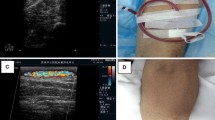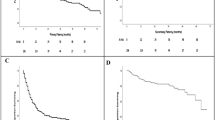Abstract
Native arteriovenous fistula (AVF) is the preferred mode of vascular access for hemodialysis. Few studies suggest that the results of AVF are influenced by the experience of the operating surgeons. The present study compares the results of the AVF surgery performed by the surgical trainees with consultant. The retrospective data of the patient operated during the period of January to December 2016 was evaluated. The primary success rate and functional status of the AVF at 1 year were compared in the AVFs created by consultant and trainees. A total of 111 patients who underwent AVF were included in the study. Out of these, 47 (41%) were forearm fistulas (radiocephalic) and 64 (59%) were upper arm fistulas. Out of the total, 57 were operated by consultant and 54 were operated by trainees. The distribution of age, gender, diabetes, and type of fistulas was similar in the two groups. The primary success was established in 91 AVF (81.9%). The failure to use the fistula for the dialysis made by trainee was 10/54 (18.5%) and 10/57 (17.5%) by consultant. There was no statistical difference in the result of AVF made by trainees and consultants (p = 0.89, chi-square test). AVFs can be safely made by resident surgeons as a part of clinical training program. This approach may be evaluated in other centers, which could train resident surgeons in general surgery in microvascular surgery and thereby reducing the waiting period for AVF creation.
Similar content being viewed by others
References
Singh AK, Farag YM, Mittal BV et al (2013) Epidemiology and risk factors of chronic kidney disease in India – results from the SEEK (screening and early evaluation of kidney disease) study. BMC Nephrol 14:114
Park HS, Kim WJ, Kim YK, Kim HW, Choi BS, Park CW, Kim YO, Yang CW, Kim YL, Kim YS, Kang SW, Kim NH, Jin DC (2016) Comparisons of outcomes with arteriovenous fistula and arteriovenous graft for vascular access in hemodialysis: a prospective cohort study. Am J Nephrol 43:120–128
Lee T (2017) Fistula first initiative: historical impact on vascular access practice patterns and influence on future vascular access care. Cardiovasc Eng Technol 8:244–254
Rai KM (2003) Vascular surgery in India. Eur J Vasc Endovasc Surg 26:227–229
Fassiadis N, Morsy M, Siva M, Marsh JE, Makanjuola AD, Chemla ES (2007) Does the surgeon’s experience impact on radiocephalic fistula patency rates? Semin Dial 20:455–457
Georgiadis GS, Charalampidis DG, Argyriou C, Georgakarakos EI, Lazarides MK (2015) The necessity for routine pre-operative ultrasound mapping before arteriovenous fistula creation: a meta-analysis. Eur J Vasc Endovasc Surg 49:600–605
Sidawy AN, Gray R, Besarab A, Henry M, Ascher E, Silva M Jr, Miller A, Scher L, Trerotola S, Gregory RT, Rutherford RB, Kent KC (2002) Recommended standards for reports dealing with arteriovenous hemodialysis accesses. J Vasc Surg 35:603–610
Santoro D, Benedetto F, Mondello P et al (2014) Vascular access for hemodialysis: current perspectives. Int J Nephrol Renov Dis 7:281–294
Pisoni RL, Young EW, Dykstra DM, Greenwood RN, Hecking E, Gillespie B, Wolfe RA, Goodkin DA, Held PJ (2002) Vascular access use in Europe and the United States: results from the DOPPS. Kidney Int 61:305–316
Regus S, Almási-Sperling V, Rother U, Meyer A, Lang W (2017) Surgeon experience affects outcome of forearm arteriovenous fistulae more than outcomes of upper-arm fistulae. J Vasc Access 18:120–125
El-Sharkawy AM, Morris DLJ, Grewal BS et al (2014) Arteriovenous fistula formations: key to vascular surgical training. J Vasc Access 15:18–21
Lazarides MK, Georgiadis GS, Georgakarakos EI (2015) What is the best training for vascular access surgery? J Vasc Access 16(Suppl 9):S16–S19
Saran R, Elder SJ, Goodkin DA, Akiba T, Ethier J, Rayner HC, Saito A, Young EW, Gillespie BW, Merion RM, Pisoni RL (2008) Enhanced training in vascular access creation predicts arteriovenous fistula placement and patency in hemodialysis patients: results from the dialysis outcomes and practice patterns study. Ann Surg 247:885–891
Gundevia Z, Whalley H, Ferring M, Claridge M, Smith S, Wilmink T (2008) Effect of operating surgeon on outcome of arteriovenous fistula formation. Eur J Vasc Endovasc Surg 35:614–618
Barnes R, Smith GE, Chetter IC (2015) A prospective observational study to assess the impact of operator seniority on outcome following arteriovenous fistula formation. J Vasc Access 16:372–376
García-Trío G, Alonso M, Saavedra J, Cigarrán S, Lamas JM (2007) Integral management of vascular access by nephrologist. Three years work outcome. Nefrologia. 27:335–339
Davidson I, Gallieni M, Saxena R, Dolmatch B (2007) A patient centered decision making dialysis access algorithm. J Vasc Access 8:59–68
Acknowledgements
We thank Dr Anup Mohta, Director Professor Department of Surgery LHMC for his feedback on the text during revision stage.
Author information
Authors and Affiliations
Corresponding author
Ethics declarations
Conflict of Interest
The authors declare that they have no conflict of interest.
Additional information
Publisher’s Note
Springer Nature remains neutral with regard to jurisdictional claims in published maps and institutional affiliations.
Rights and permissions
About this article
Cite this article
Saha, S., Vats, M., Gupta, R. et al. Can Native Arteriovenous Fistula Be Safely Made by Trainees? Comparison of Results of Native Arteriovenous Fistula for Vascular Access Made by Trainees with that by Consultant. Indian J Surg 82, 367–370 (2020). https://doi.org/10.1007/s12262-019-01963-8
Received:
Accepted:
Published:
Issue Date:
DOI: https://doi.org/10.1007/s12262-019-01963-8




